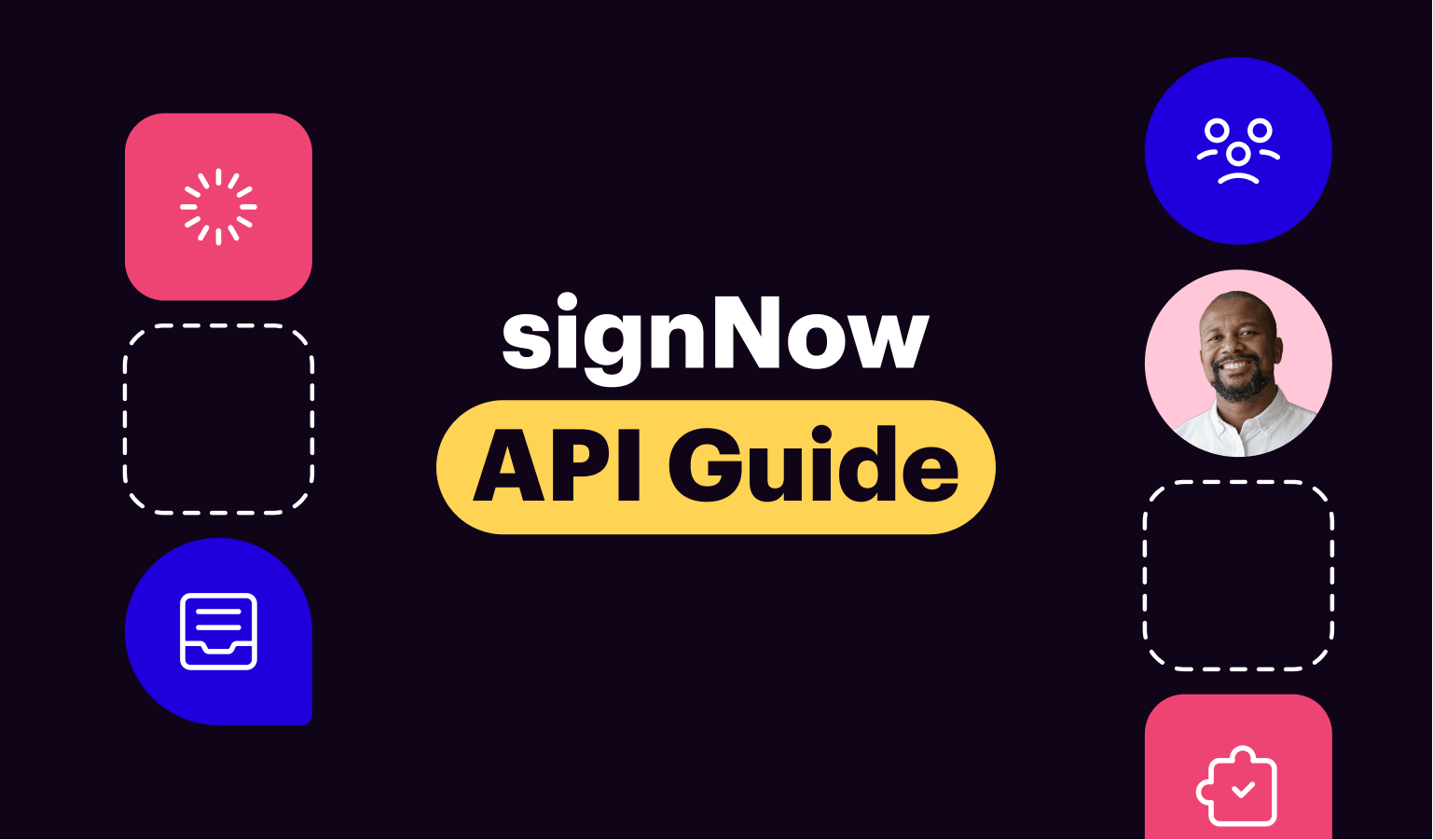
In addition to providing users with a convenient application to streamline complex eSignature workflows, signNow also offers a comprehensive API. Using the signNow API, developers can seamlessly integrate electronic signature workflows with other software products.
Equipped with detailed documentation, the signNow API ensures a smooth and hassle-free experience when implementing eSignature processes in your app, website, CRM, or cloud storage. What’s more, it’s possible to test the signNow API for free in a Sandbox environment.
If you’re not familiar with the concept of an API or want to know more about the signNow API in particular, this article is the best place to start.
We’ll introduce you to API basics, guide you through the essential features and principles of the signNow API, and help you make the first steps towards integrating eSignatures in your products.
What is an eSignature API?
In the tech and software world, API stands for Application Programming Interface.
An API is a set of code that allows two different software products to interact with each other and exchange data under predefined conditions.
Much like humans need an interface to interact with software (graphical menus, keyboard, mouse, etc.), applications and websites need interfaces to interact with one another. The only difference is that applications use code for interaction.
But how are software solutions supposed to interact with each other? Here’s a typical example:
- An application requires certain data or functionality provided by another application, and it sends a request to the latter by calling its API (let’s say a booking website requests the information on room availability or rates from a hotel’s database).
- An API enables one application to specify what data or functionality is required and how it must be delivered. It also makes it possible for another application to understand these requirements.
- As a result, the other application responds by returning the requested information/functionality to the former app.
The same principle applies to signNow’s eSignature API. Your application, website, or CRM may use the API to have signNow send a document or document group for signature to one or multiple recipients, check the status of a document, download a signed file, and so on. This means you don’t necessarily have to use the signNow desktop or mobile app. Instead, you can get your documents eSigned inside your own application – by means of the signNow API.
7 reasons to use the signNow API
Having signNow’s eSignature workflows embedded in your application provides the convenience and seamlessness needed to streamline operations and automate eSignature processes within your app.
signNow successfully manages millions of API calls generated by our customers — to date, the total number of API calls has already exceeded 16.5 billion.
With 10.7k signatures using the signNow API per day, it’s easy to keep your business moving forward and enjoy a hassle-free way of collecting eSignatures within any integrations — whether it’s a website or CRM system.
For instance, it’s much easier to send eSignature invites to clients directly from your CRM than to switch to another app and do it from there. This way, you consolidate your tools, save time and hassle performing routine tasks, and eliminate a number of manual processes.
For software vendors, integrating signNow eSignature functionality with their products helps create more value for end-users while keeping branding consistent. The signNow REST API works seamlessly with any software solution, supports five programming languages, and scales with your needs and use cases.

The signNow API helps independent developers and businesses build powerful eSignature integrations within various software frameworks. Trusted by 318 Fortune 500 companies since 2017, signNow outshines the competition for the following reasons:
- Easy and fast setup. It takes no longer than ten minutes to create a Sandbox account to test signNow API for free, and start building your integration.
- Powerful features. Configurable eSignature workflows for companies of all sizes to keep your business moving ahead.
- Security and compliance. The signNow API uses the OAuth 2.0 protocol for authentication and complies with 21 CFR part 11, SOC 2 Type II, HIPAA, GDPR, eIDAS, and PCI DSS security standards.
- Excellent developer and end-user experience. signNow provides API users with detailed documentation for REST and SOAP implementations, SDK libraries in five programming languages (PHP, Java, .Net, Python, Node), comprehensive video guides, and solution engineering services.
- Competitive and scalable pricing. Developers can test the signNow API for free – each Sandbox account gets 250 free signature invites. After that, you can purchase a subscription starting at $84 per month. The subscription price scales depending on how many signature invites per year you need. Companies with large transaction volumes and unique business models are offered custom pricing plans.
Take note: All documents sent for eSignature through the Sandbox account are not legally binding. - Exceptional stability. signNow maintains 99.9% API uptime and superior performance with 24/7 API monitoring.
- Self-service. No need to contact sales representatives to test or purchase the API.
What capabilities does the signNow API offer?
signNow is an award-winning eSignature solution that allows you to electronically sign documents and send them for signature to other parties. The signNow API provides your application or website with eSignature functionality for building custom workflows that match your individual needs.
With the signNow API, you can complete an entire document approval cycle:
Upload documents with fillable fields
- Generate fillable forms by adding signature, text, date, initials, checkbox, radio button, or dropdown fields to documents.
- Create advanced forms by using conditional, calculated, payment, attachment, or smart fields.
- Add fillable fields outside of the signNow application. Insert text tags containing field presets (field type, size, location, etc.) into your document using any word processor. Text tags will convert to fillable fields once you upload a document to signNow.
Prepare documents for sending
- Pre-fill documents from your app or website without having to type data manually.
- Organize documents in groups (packages) to send them to one or several recipients.
- Save fillable templates and use them to create as many document copies as you need.
Send documents for eSignature
- Create role-based signature invites. Assign a signing role for each recipient and set up a signing order.
- Send freeform invites. Enable recipients to add their signature anywhere on a document.
- Share eSignature links. Let users access any of your document templates and sign their own copies.
- Send eSignature invites in bulk to get multiple recipients to sign documents at once.
- Sign or send documents for signature inside your own website or application.
- Set signer reminders and notifications to make sure your documents are signed without delay.
- Protect your documents with a password or by using other signer authentication methods.
- Add payment fields to documents to request payments for services along with eSignatures.
Check the status of documents
- Check whether a document has been signed or is still pending. Track when exactly an eSignature invite was created and to whom it was sent.
- Retrieve a document’s audit trail to review an entire log of actions and changes made to it.
- Track events and actions after you send documents for signing inside your signNow account directly from your app using webhooks.
Download signed documents
- Save signed documents to your computer, cloud storage, or CRM and access them anytime.
In addition to the features listed above, the signNow API allows you to improve collaboration by creating multiple teams inside your organization. Team members can share documents and document templates to build efficient workflows. What’s more, you can use signNow eSignatures with your own branding by adding your logo to signing invites.
Getting started: Test the signNow API for free
signNow provides the easiest way to get started with collecting eSignatures within your site, platform, or CRM. To date, 21.7k API Sandbox accounts have already been created by customers to test the capabilities of the signNow API. More than that, each Sandbox gets 250 eSignatures complimentary.
One of the indisputable benefits of the signNow API is the simplicity of the setup process. As mentioned before, you don’t have to contact support or sales representatives to get hands-on experience with the API.
To get started, create your Sandbox account and test the essential API calls completely free of charge. Once you have a grasp of the basic features and functions, you can easily subscribe to a suitable API plan and start building your eSignature integrations. Now, let’s break down the process into a few steps.
1. Create a Sandbox account
Go to the signNow developers page, enter your email address, and click Create my API Sandbox. You will instantly receive an email containing an activation link. Follow it and set up a password to access your personal API dashboard.

2. Explore the signNow API Dashboard
Once your account is created, you will be redirected to the signNow API Dashboard. Here you can access the Dashboard anytime by clicking the API button on your signNow home screen.
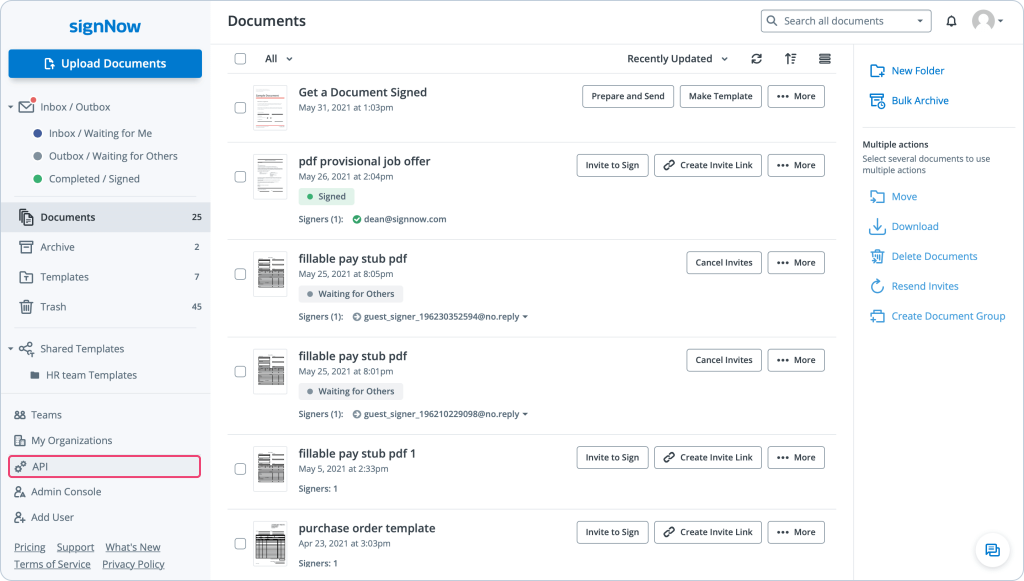
Inside the dashboard, in the Keys section, you’ll find your test app. Click on it to see your Client ID, Client Secret, and Basic Authorization Token (generated automatically). You can also add your own application for testing by clicking the Add App button.
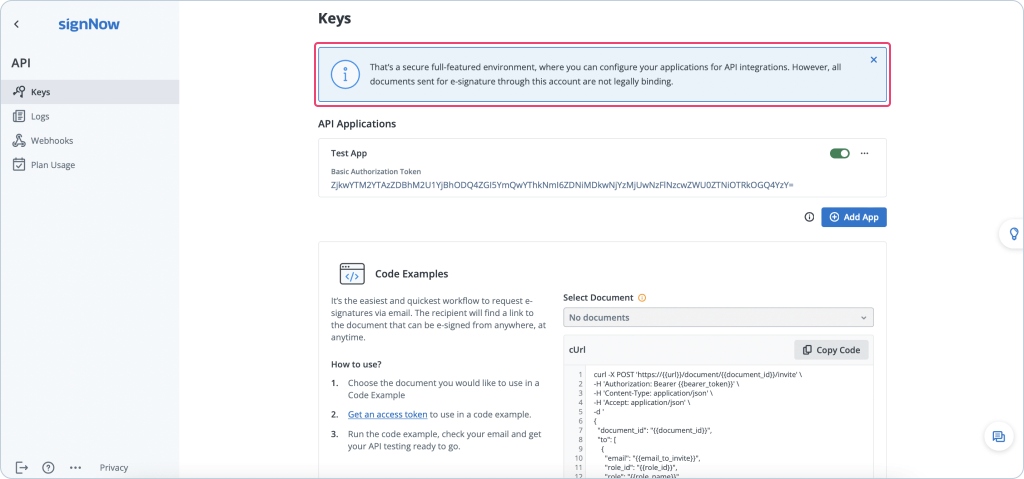
Your dashboard is the best place to start exploring the signNow API as it provides you with your app’s credentials and code examples that you can freely test. But before testing an API call, you need to create a Bearer token.
3. Generate a Bearer token
A Bearer token is an authentication code that identifies you as a user in the system. To generate a token, use any API management software (like Postman, for example):
- Switch from GET to POST.
- Specify the endpoint.
- Set up headers:
- Key: Authorization; Value: Basic [your Basic Authorization Token] (copy from the Dashboard)
- Fill in the body of your request:
- Key: username; Value: [your Sandbox email address]
- Key: password; Value: [your Sandbox password]
- Key: grant_type; Value: password (the authorization code and refresh token options are also supported)
- Key: scope; Value: *
- Send your API request.
You will receive a response containing your Bearer access token. Please note that it expires in 30 days, so you’ll need to refresh it.

4. Send an eSignature invite via the API
Go to the API Dashboard. Your account comes with two documents by default which you can use when testing the signNow API (with one or two signer roles that are already configured). Select either of them. Then, copy the cUrl from the Code Examples section and run the code with your API management app.
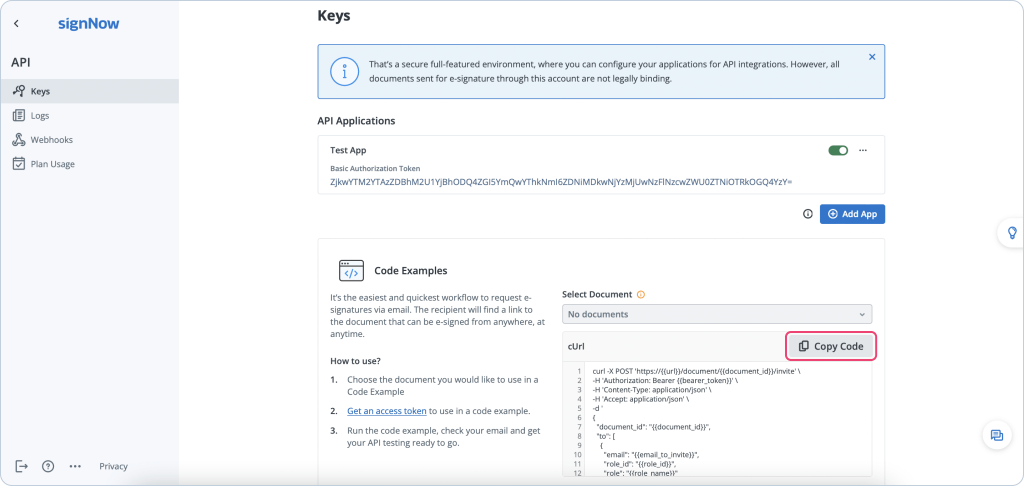
Note: Don’t forget to insert your Bearer token into the request (the access code you obtained from the previous step).
Check your email. If the code has been run correctly, you will find your eSignature invite in your inbox right away. Please note that documents signed in test mode are not legally binding. Please note, that a separate document or a document group signed in test mode are not legally binding.
For a more detailed tutorial on how to send documents for signing or use the signNow API to send an Invite to Sign, check out the video below.
Also, explore one of our recent blogs on how to create a freeform or role-based invite using the signNow API.
5. Move on to the production environment
Once you have tested the signNow API in the sandbox environment, you can go live whenever you’re ready. Hit Go to the API Production in your API dashboard and select your subscription plan to enable legally binding eSigning for your software products.
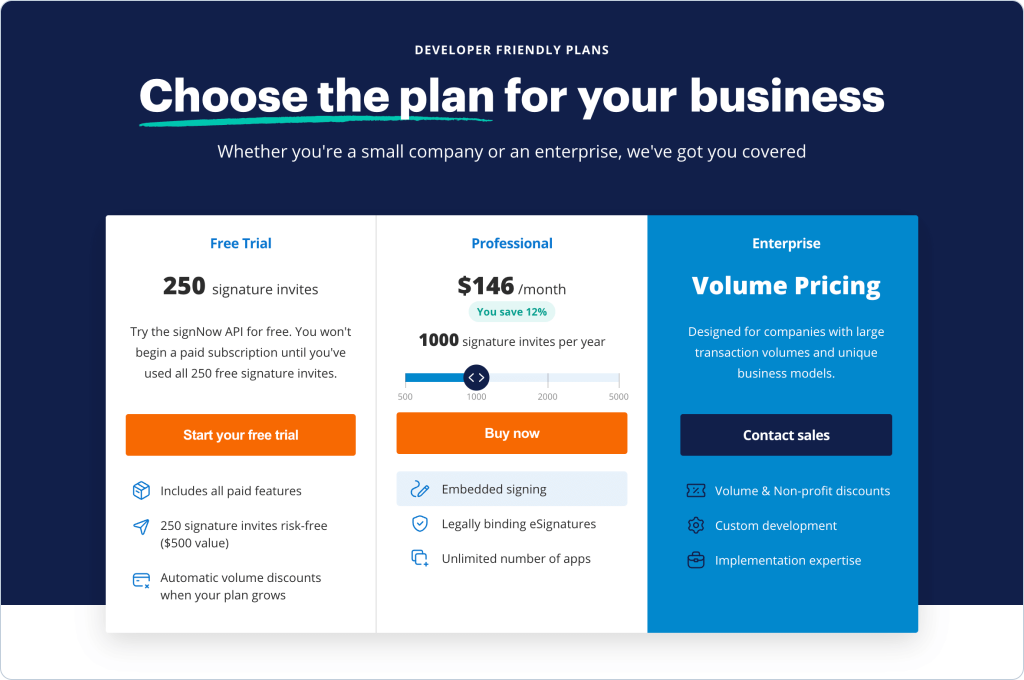
For more information on the signNow API, its features, and references, please view our detailed documentation.
Build your own eSignature integration
Note that we’ve barely scratched the surface of the signNow API in this brief guide. But hopefully, it gives you a better understanding of its capabilities and how your own product stands to benefit from them. You can test-drive the signNow API for free by creating a Sandbox account. If you have any questions or would like to discuss the API functionality or terms, you might need to contact sales for more information.
Editor’s Note: This post was originally published in June, 2021 and was completely revamped and updated in May, 2022 for accuracy and comprehensiveness.

